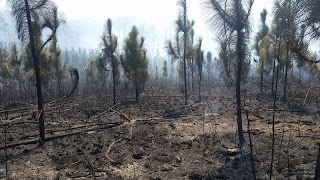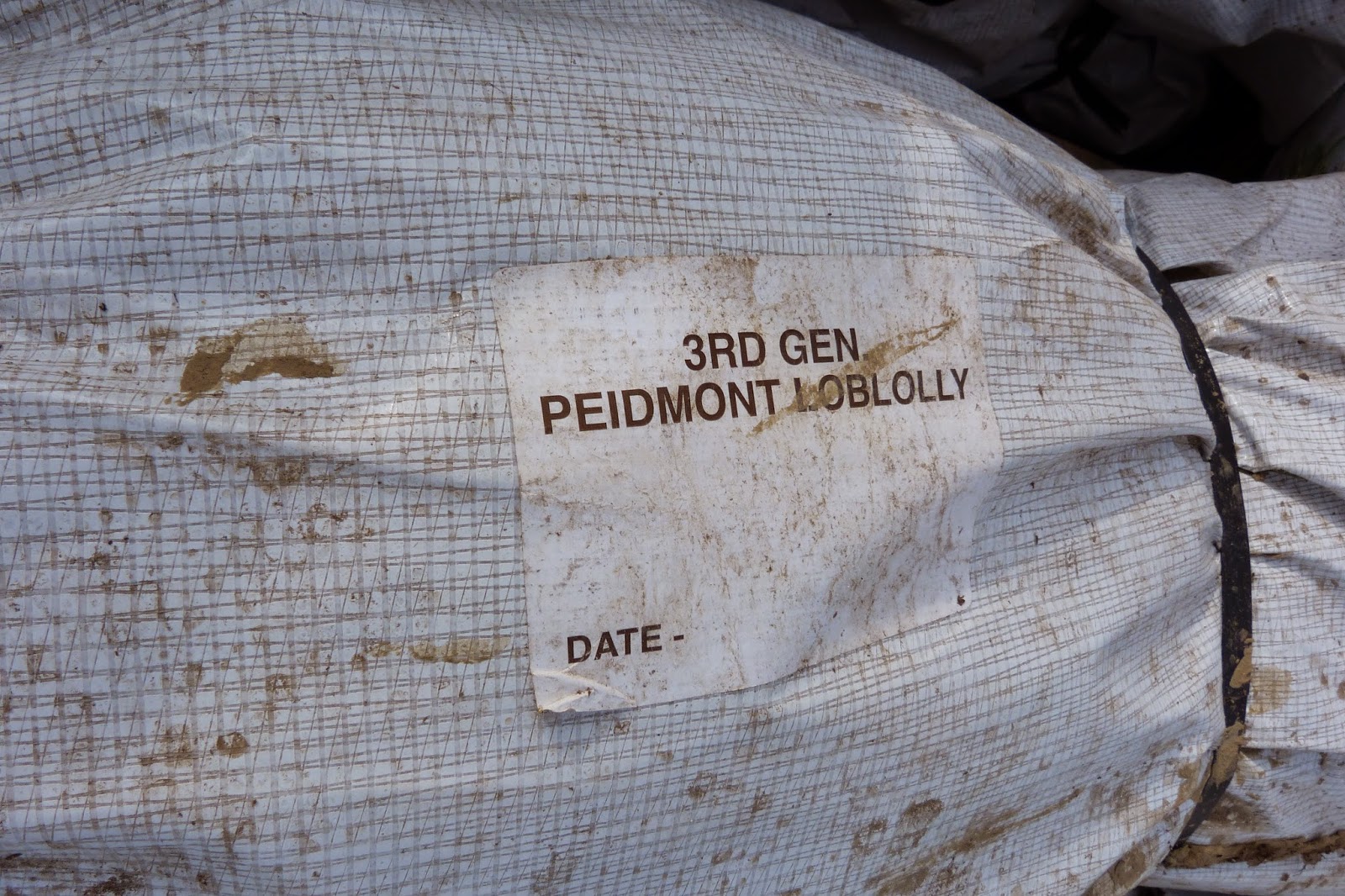Here you will find information about timber management on private forestland.

Prescribed Fire on Longleaf Pines
Back in February we did a burn on two year old longleaf pines. The purpose of the burn was to help control loblolly pines that had come up in the stand from seeds. Below are some of the pictures and a video from the burn.
Prescribed Fire Pruning
I wanted to share a picture of a stand of 22 year old loblolly pines that had a prescribed fire under them this last spring, about March 22. This is later than I like to burn but it was the best time we had with the weather like it had been up to this point. Below is the results of this late burn which got hot, a little hotter than I like.
Because it was later and the fire was hotter, it killed the lower limbs on the trees. This was a bonus to the prescribed fire because it took out much of the under-story and it also served as a natural pruning of the trees which will add to the value of the wood at a later date. The pruning was an unintended consequence with valuable results. It will be interesting to watch this stand and see what the trees will look like in the next five to ten years.
Before And After
Longleaf Pines
Here you will see some of the reasons prescribed fire is such a good tool in forest and wildlife management. Not all the advantages will be discussed but you will see enough here on the why of prescribed fire.
Below is a picture one week before a prescribed fire is used on this four year old, forty acre tract of longleaf pines.
And here is the result of the burn a week later.
Longleaf pines thrive in an area that is burned regularly . This tract was burned two years ago so this is the second time fire has been used on these longleaf pines.
The fire removes competition from the stand and increases the browse for wildlife. I think a well managed stand of longleaf pines is as good as any food plot you can plant for deer and turkey.
Three Months Later
This is the same spot three months later. The wildflowers are beautiful but most of all the browse for wildlife is abundant. There are many legumes on the ground.
Loblolly Pines
The next day we used a prescribed fire on this twenty-two year old stand of loblolly pines. This fire was about 130 acres and it made the forth time this stand was prescribed burned for management.
This is what the stand looked like before the prescribed fire. Notice how little there is for wildlife to eat. The under growth has become woody and the forest floor has only pine straw.
After the prescribed fire most of the woody undergrowth is burned or killed. This causes new tender growth to emerge in about a week and more sunlight can reach the forest floor to cause forest legumes to germinate. This really increases the food available to wildlife.
A prescribed burn program also protects the forest from wildfire. If the weather turns off dry and wildfire becomes a problem then this stand is protected because a hot wildfire can't burn through this stand.
In just a few days this under-story will be as green as any place you can find in a forest.
Planting The Next Generation of Forest
The next generation of trees have been planted on this tract of land. We were planting last Friday and today is Tuesday and have had no sunshine on these trees. We have had small showers and today's forecast is for 3-5 inches of rain. Perfect weather on these trees! This rain will help firm the soil around the roots. Most or nearly all should live.
In the above picture you will see a longleaf seedling that has been planted. The seedling is planted with the root collar being 3/4 to 1 inch above ground level. Research has shown that this will help the tree to come out of the grass stage (as seen above) quicker. We planted longleaf containerized seedlings and the other plot we planted bare-root loblolly seedlings.
You might ask why on one site you plant longleaf seedlings and on the other loblolly? We are now planting longleaf seedlings on all of our sites that allow us to use prescribed burning as a management tool. The longleaf trees are the best trees to plant where fire can be used as a management tool but some sites are not conducive to the use of fire, so those sites are planted in loblolly seedlings. We are trying to convert as much of our property back into the native species, longleaf pines. As you see in the picture above, loblolly and shortleaf cones are on the ground near the seedling, this shows why you have to use herbicides and fire to prepare the site for planting longleaf pines. Competition has to be controlled to establish a site back to the native species.
This planting crew is doing a great job. They were so thankful for such a clean site to plant. These guys are such hard workers and I salute them. They amaze me. The best I have ever been able to do planting is about 1000 trees per day. These guys plant 3000 per day!
A new longleaf forest is now here and they will grow fast with a little management. You can tell the longleaf pine is my favorite tree.
Containerized longleaf seedlings come in boxes,
and bare-root loblolly seedlings come in bundles. Loblolly pine seedlings will survive just as good when planted as bare-root so there is no need to pay for the additional cost for containerized loblolly seedlings.
So what is the cost for establishing a new forest? The figures are my cost and may vary from region to region. To establish one acre of longleaf pines the cost is about $305/acre and for the loblolly pines about $205/acre. This includes firebreaks, herbicide application, prescribed burning, and tree planting.
Site Prep Burn
A site prep burn is one of the most difficult prescribed burns to complete with success. There are so many factors that effect the outcome of the burn. Humidity has to be right, wind has to be stronger than an under-story burn to get a good clean burn, and the direction of the wind is also important to control the smoke. You can't wait until next year and burn because you will be planting in a few months so there is a smaller window of opportunity to burn.
You can tell by the smoke we had strong winds because the smoke is staying closer to the ground before rising.
Because of the wind speed we started lighting the fire downwind. This was to make the fire break larger as the fire burned. Fire breaks were put in days before we started the fire.
As the fire backed against the wind we continued to light the fire down the firebreak. After completely lighting the fire against the wind and letting it back off the firebreak we started lighting the fire with the wind. This causes the fire to burn hotter and faster as it moves across the planting site. This site was sprayed with herbicides about two months ago to aid in killing the plant growth to help the site burn better and also kill unwanted vegetation on the site.
(Look down this page to "Herbicide Application" to see what the site looked like before herbicides and fire.)
(The above picture is the day after the burn and Nic Jordan with the Alabama Forestry Commission is examining the results of the fire.)
This tract is going to be planted in longleaf pines. Loblolly pines were harvested off of this tract and they really put out the seed and the ground, in spots, was covered in seedlings. You don't want these seedlings in a stand of longleaf so there is such a need for a good killing fire, moonscape as we say. If this was a site for planting loblolly pines the killing of the seedlings wound not be as important but it is still better to have the natural seedlings removed because you would end up with too many seedlings per acre, hindering the production on the site.
This will be easy to plant and there are no weed trees on this site. The longleaf seedlings will be planted this winter. These trees will do very well here and get off to a good start in their growth to became lumber for homes, poles for energy and this site will be a home for wildlife starting next summer. There will be an abundance of wildlife food in this area because of the native species of longleaf pines being planted and managed for years to come.
Longleaf Pine Management
There was a prescribed fire put through these longleaf pines in February of this year. These trees are about three and a half years old. The little man standing next to the tree in the picture is about four feet tall. The picture below is what the trees looked like immediately after the burn in February 2014.

Herbicide Application
8/6/2014 Site Preperation for the Planting of Longleaf and Loblolly Pines
We are in the process of getting ready to plant longleaf pines and loblolly pines this winter. That preparation starts in the summer to ensure a good planting of these trees. This site was harvested last fall and we are preparing for the new forest to grow on this site.
The workers here are preparing there equipment for spraying. Fire breaks have been put in to control the fire when we do a site prep burn but they are also to help the sprayers to know where the herbicide is to be used to control unwanted plants. On the longleaf site we have to kill all the loblolly pines to keep them from competing with the longleaf. It is not as big of a problem on the loblolly site but too many seedlings can be a big problem because the competition slows the growth of the trees.
The spraying crew does a good job in applying the herbicides.
Our next job will be burning the sites after the vegetation dies. This will be at least six weeks away to give the herbicide time to work.
Forest Management, Does It Pay?
The answer is... in more ways than one. Below are two pictures made on the same day.
Can you guess which stand is seven years older than the other? The answer is: the top picture.
This stand has never had any management practices carried out on the property. The picture at the bottom has had prescribed fire run through it, at ten this stand was thinned with all wood being chipped on site, and now at fifteen it has been thinned again. Most of the wood was sold as pulpwood but there was some sold as chip-n-saw.
The stand can be walked through. The aesthetics is more pleasing. Wildlife love this stand because more sunlight can get to the forest floor. The more sunlight, the more food for wildlife.
Cutting timber in a managed way is nothing but profitable: financially, to wildlife and aesthetically.
Here you can see why we manage.
Prescribed Fire
Below is a video produced by Nathan Dewberry of Dewberry Lands. This video is of a prescribed burn of eight year old longleaf pines. That day in February the temperature was about 12 degrees when we started the fire. We burned 55 acres and got a near perfect burn.

























No comments:
Post a Comment